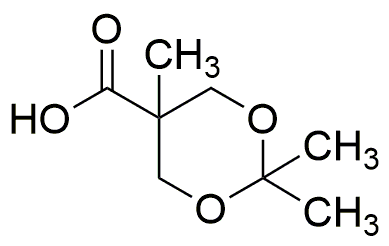2,2,5-Trimethyl-1,3-dioxane-5-carboxylic acid is widely utilized in research focused on:
- Pharmaceutical Development: This compound serves as a key intermediate in the synthesis of various pharmaceuticals, enhancing the efficacy of drug formulations.
- Polymer Chemistry: It is used in the production of specialty polymers, providing improved thermal stability and mechanical properties compared to traditional compounds.
- Cosmetic Formulations: The compound acts as a stabilizer and emulsifier in cosmetic products, ensuring a smooth texture and prolonged shelf life.
- Agricultural Chemicals: It finds application in the formulation of agrochemicals, contributing to more effective delivery systems for pesticides and herbicides.
- Analytical Chemistry: This chemical is utilized as a reference standard in analytical methods, aiding in the accurate quantification of similar compounds in complex mixtures.
General Information
Properties
Safety and Regulations
Applications
2,2,5-Trimethyl-1,3-dioxane-5-carboxylic acid is widely utilized in research focused on:
- Pharmaceutical Development: This compound serves as a key intermediate in the synthesis of various pharmaceuticals, enhancing the efficacy of drug formulations.
- Polymer Chemistry: It is used in the production of specialty polymers, providing improved thermal stability and mechanical properties compared to traditional compounds.
- Cosmetic Formulations: The compound acts as a stabilizer and emulsifier in cosmetic products, ensuring a smooth texture and prolonged shelf life.
- Agricultural Chemicals: It finds application in the formulation of agrochemicals, contributing to more effective delivery systems for pesticides and herbicides.
- Analytical Chemistry: This chemical is utilized as a reference standard in analytical methods, aiding in the accurate quantification of similar compounds in complex mixtures.
Documents
Safety Data Sheets (SDS)
The SDS provides comprehensive safety information on handling, storage, and disposal of the product.
Product Specification (PS)
The PS provides a comprehensive breakdown of the product’s properties, including chemical composition, physical state, purity, and storage requirements. It also details acceptable quality ranges and the product's intended applications.
Certificates of Analysis (COA)
Search for Certificates of Analysis (COA) by entering the products Lot Number. Lot and Batch Numbers can be found on a product’s label following the words ‘Lot’ or ‘Batch’.
*Catalog Number
*Lot Number
Certificates Of Origin (COO)
This COO confirms the country where the product was manufactured, and also details the materials and components used in it and whether it is derived from natural, synthetic, or other specific sources. This certificate may be required for customs, trade, and regulatory compliance.
*Catalog Number
*Lot Number
Safety Data Sheets (SDS)
The SDS provides comprehensive safety information on handling, storage, and disposal of the product.
DownloadProduct Specification (PS)
The PS provides a comprehensive breakdown of the product’s properties, including chemical composition, physical state, purity, and storage requirements. It also details acceptable quality ranges and the product's intended applications.
DownloadCertificates of Analysis (COA)
Search for Certificates of Analysis (COA) by entering the products Lot Number. Lot and Batch Numbers can be found on a product’s label following the words ‘Lot’ or ‘Batch’.
*Catalog Number
*Lot Number
Certificates Of Origin (COO)
This COO confirms the country where the product was manufactured, and also details the materials and components used in it and whether it is derived from natural, synthetic, or other specific sources. This certificate may be required for customs, trade, and regulatory compliance.


